

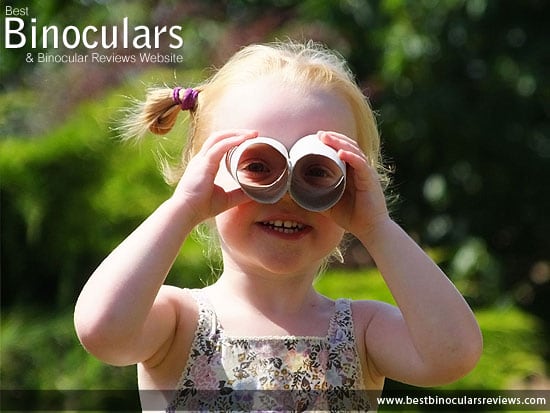
Binocular Reviews Home > Binocular Guides > Best Binoculars for Children
Children's Binoculars
From preschoolers to teens, in this article I offer some advice with recommendations as to what I feel makes the best binoculars for a young child, slightly older grade school kid as well a teenager reaching for adolescence:
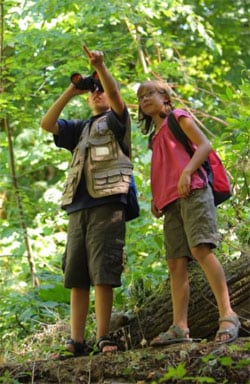 II started the BBR website before my daughter was born, she is now almost 9 years old and during that time I have watched her go from a toddler imitating me by holding up a couple of toilet rolls to her eyes, to the point where she can now competently use many of the binoculars that I have around me, in for testing and review.
II started the BBR website before my daughter was born, she is now almost 9 years old and during that time I have watched her go from a toddler imitating me by holding up a couple of toilet rolls to her eyes, to the point where she can now competently use many of the binoculars that I have around me, in for testing and review.
So I can speak from personal experience when I say that having your kids involved in what you are interested in is a really rich and rewarding experience, especially when it is educational as well. Think about it, what could be better than having your child playing outdoors and at the same time learning about and enjoying the wonders of nature all around them.
If your kids are anything like my daughter, then they will want to join in and do many of the things that you are doing, even if its just copying dad by using a couple of toilet rolls!
But there will come a time, especially as your kids grow older when a pair of non-working "toilet-roll binos" won't cut it anymore, but at the same time, the instrument that you are using is most likely not ideally suited to small, sticky and often shaky hands that have a tendency to drop just about everything they touch!
The ideal alternative to having your kids smudging the lenses and potentially damaging your expensive optics is to get them a cheaper pair of binoculars that are not only less painful for you to replace should they drop them, but will actually make it easier for them to use and thus means they will probably use and enjoy them more.
Exactly which binocular and what type of binocular to get for your child depends a lot on their age and experience in using them, which I will go through in order below:
Cheap Toys
After a quick search online, you will find that there are quite literally thousands of "children's binoculars" on the market, the problem is, most are nothing but very cheap toys that do little more than blur the image when you look through them!
With a pair of these don't be surprised if your child's interest in using them is very short-lived.
Real Working Binoculars
So to prevent this, I will point out the all the important features to look out for that make an ideal binocular for a child, present the instruments that my daughter and I have tested and reviewed over the years as well as take a look at what we feel are the best available taking into account your budget as well as your child's age:
Below are the most important features and aspects to keep in mind when looking for a good pair of binoculars for kids:
Avoid high power binoculars. I would say that even for teenagers, the maximum magnification for almost all hand-held uses should be 8x.
Whilst high powered binoculars sound exciting and you may think you will see more, there are many downsides to higher magnifications, even for adults, but which have an even greater impact when younger eyes are using the device:
Image Shake
Firstly, any movement that you make with your hands gets multiplied because of the magnification. Therefore, a high powered binocular with a highly magnified image is much harder to keep still and shake-free which in turn makes it much harder to achieve a good view of what you are trying to look at.
As you know kids find it hard to stay still at the best of times and they tend to have less stable hands than adults, so if they only see a blurry, shaky image when looking through their bins, it won't be long until they get bored and give up trying to use them.
Exit Pupil Size
A lower-powered binocular will also produce a larger exit pupil than one with the same size lenses, but a higher magnification.
This means the image will look brighter in poor light but makes and makes it much easier for your child to line up their eyes with the shafts of light exiting the eyepieces.
This, in turn, makes the binocular far easier for them to use and ensures they see the full image without any dark rings forming on the edges of the view.
Wider View
Another advantage of keeping the magnification down is that lower-powered bins will produce a wider view, which also offers a number of advantages important for everyone, but especially important for kids. For more, see field of view below
A wide field of view (the width of the image that you see through your optics) will make it much easier for your child to locate what it is they are looking for through when they bring the binoculars up to their face.
Then on top of this, it also makes it easier for them to follow fast-moving or erratic objects like birds for example.
So if you have a choice between two binoculars that are very similar in all other aspects, take a look at their FOV's and go for the one that is wider.
Tip: Binoculars with higher magnifications have a more zoomed-in image with a narrower field of view, so to help make sure you get a wide view, keep the magnification to under 8x and possibly look for bins with a 7x or even 6x power.
Binoculars with large objective lenses take in more light and therefore, in general, will produce a brighter image which is optimal. The downside to this is obviously that the binoculars become larger and heavier.
Standard sized binoculars are optimized for larger hands and so it will be difficult for your child to hold the steady and especially difficult for them to adjust the focus wheel.
So even though they may not perform as well, I would still recommend that you opt for pocket or compact binoculars for younger children and then possibly a mid-sized instrument for teenagers. This will make it much easier not only for your child to carry, but also to hold up to their face and keep steady.
The two images below are of my two and a half year old daughter showing off that she "can use my binoculars" and even one handed! However whilst these Hawke Nature-Trek 8x42 Open Hinge binoculars are particularly lightweight, I would not suggest getting them specifically for your child. What these pics do not show is how long she could hold them for or how steadily she was holding them!
Interpupillary Distance (IPD)
Another reason for choosing a smaller binocular is to ensure that the eyepieces can be positioned close enough together to accommodate the smaller face and thus closer set eyes on a child.
If you do decide to get a binocular that has not been specifically designed for children, something to look out for is the minimum Interpupillary Distance (IPD) setting.
Most manufacturers advertise both the maximum and minimum IPD distances that you can adjust their binoculars to, so you just need to make sure that the binocular barrels can be adjusted to match the width between the centers of the pupils in each eye of your child.
To be 100% sure before buying, just measure the distance between the centers of your child's eyes and make sure that the binoculars you do choose can fold down to this distance or less, but for older children a binocular with a minimum IPD of around 5.1cm - 5.3cm should easily accommodate their smaller faces.
Price - How Much Should You Spend?
This is a personal and in many cases a relative option as what may be expensive to you and I will be considered pretty cheap to someone like Bill Gates or Elon Musk!
However, what I would like to recommend is that firstly you should try and avoid the very cheapest binoculars in any age class as they are often so bad that they will usually only end up frustrating your child and eventually put them off using them altogether.
Then secondly, I would also say that you should only go for a pair that you can easily afford to replace. This is especially true for younger kids!
The best binoculars designed specifically for children do factor in the fact that they will inevitably be dropped, but even so, they will contain delicate optics within them that can become misaligned no matter how tough you build the exterior.
So now we know the most important features to look for, we still have a couple options available depending on your budget, what the age and interests of your child are:
A pair of binocular that has been specifically designed with children in mind should have all of the features listed above. This however is sadly not always the case.
Children's binoculars come in a few guises: ones that are little more than toys and are really not suitable for anything other than pretending to look through them. Then there are a few ones that are actually pretty decent binoculars and with many of the features that we are looking for and then are just a couple that are truly great.
Sure you have to pay a little more, but you can be sure that not only are you getting an instrument that is designed with kids in mind, but also uses the same optics and features as that of the adult versions.
These lower cost instruments are more suited to younger children or for those looking for a less serious and cheaper pair of optics. I have chosen pairs that still perform remarkably well and are still MUCH better than many of the toys that you find on the web:
 Made by the German optics company Bresser and based on the very successful Bresser ExploreOne 6x21 Junior Compact binoculars (see below), these National Geographic kid's binoculars maybe bright and colorful, but they are certainly more than just a toy.
Made by the German optics company Bresser and based on the very successful Bresser ExploreOne 6x21 Junior Compact binoculars (see below), these National Geographic kid's binoculars maybe bright and colorful, but they are certainly more than just a toy.
Indeed they are a fully functional roof prism compact binocular that have the optical performance that matches that of a standard 'adult' compact binocular at the same sort of price level, and are both my and my 7 year old daughter's top choice for younger children:
What I Like:
As we have already discussed, the 6x magnification is ideal for children, helping them to keep the image shake free and ensuring a wide view to make finding their intended subject easy:
At 360ft wide at 1000yds, the width of view is indeed nice and wide which is great news as I know from my daughter that one of the biggest things that younger kids struggle with is actually finding what they want to look at.
The shape is very compact and thus ideal for small hands and they have a large centrally located focus wheel that is easy to reach. The National Geographic Kid's binocular is also very lightweight, which once again is ideal for youngsters.
I also like the tough housing: The main chassis is made from a polycarbonate plastic and the exterior is rubber armored to withstand the inevitable knocks and bumps.
These instruments also come with a soft carry pouch, wrist strap and cleaning cloth, just like Mum and Dads!
The optical glass that Bresser use in these is coated with an anti-reflective coating for a brighter and better quality image than what you get on the many imitation kids binoculars that don't have any coatings and which are now available.
Just like standard binoculars, these have a diopter adjustment ring to calibrate them to cater for any differences in vision between the left and right eyes.
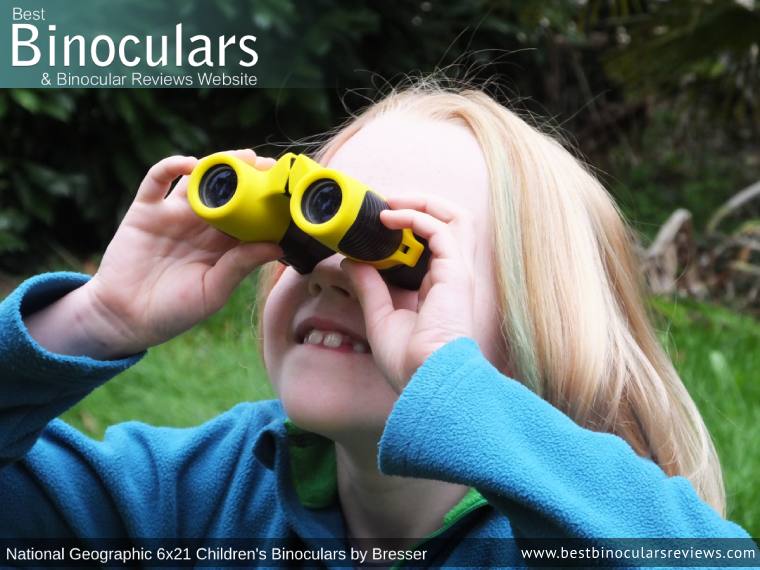
Age Range
Levenhuk suggest that these are suitable for children of 4 years and above which is about right, however I know from experience that my daughter was capable of using the very similar Bresser ExploreOne 6x21 Junior Compact Binoculars from around 3 years old. Since then we tested and reviewed this exact National Geographic model when she was 7 and whilst she has access to loads of other binoculars this is her favorite.
As for a maximum age, a lot depends on their previous exposure to optics, but these should be perfectly fine for kids of about 10 or 11 years old. For older or more experienced kids, take a look at some of the standard compact binoculars that I suggest below.
One last thing to mention is that these have an IPD range of 5cm to 6.3cm. So, once again perfect for smaller faces with closer set eyes.
Reviews
Price Range
Absolutely perfect for younger kids and good your the parents bank balance too! Originally priced at around $30 / £30 / €30, you can currently find them on offer for about $15 in the US, €15 in Germany and Europe and £15 in the UK.
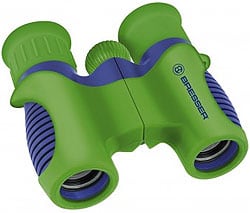 Produced by Bresser, these 6x21 Junior Compacts are very similar to the Levenhuk's above.
Produced by Bresser, these 6x21 Junior Compacts are very similar to the Levenhuk's above.
They come with Bk-7 prisms and has a fully coated optical system that delivers crisp, colorful images to the eyepieces.
The body of the binocular is rubber armored to withstand plenty of punishment.
Bresser Junior Compacts come with a five year guarantee. Also included is a neat carrying case and small wrist strap.
Reviews
Price Range
These great little binoculars are available for approx $20 in the US and £20 in the UK:
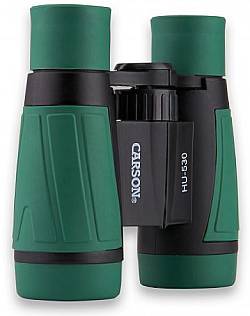 Of all the child specific binoculars currently on the market, the Carson HU-530 Hawk is one of my favorites for slightly older kids who are not quite yet ready for standard optics and here is why:
Of all the child specific binoculars currently on the market, the Carson HU-530 Hawk is one of my favorites for slightly older kids who are not quite yet ready for standard optics and here is why:
Larger Lenses
One of the main reasons for this is unlike the more compact kids binos that you commonly find (like the ones below with 21mm lenses) this Carson Kids binocular uses larger 30mm objective lenses, yet it is still small and lightweight enough for a young person with small hands to steadily hold onto.
There are a number of very important advantages to this which cannot be understated:
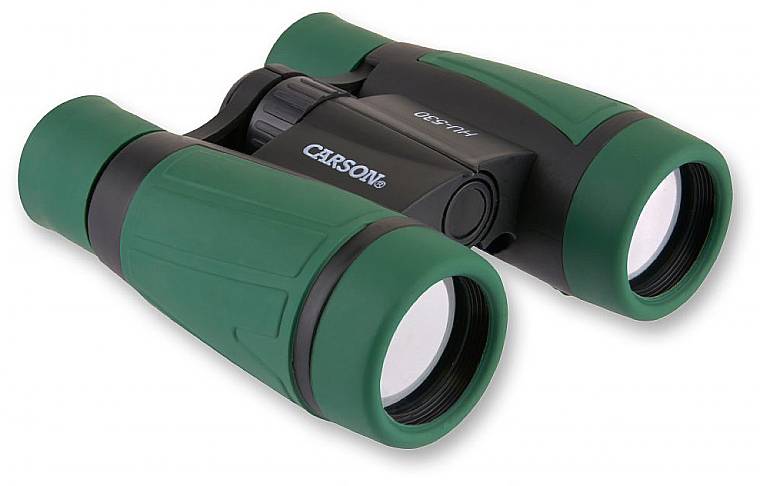
5x Power
As already mentioned, a low magnification is what you want for your children and at 5x, I think that Carson have got it spot on here.
This makes sure that the field of view is nice and wide (312 ft. at 1000 yards) which makes it easier for them to find the object that they are looking for and you get far less image shake. This it is easier for Children, who as we know can't keep still to get a nice steady image for a better view.
Carson have used real optical glass on these binoculars (not plastic like some toys have ) and the prisms use BK-7 glass, which is fine, but not as good as the BaK-4 glass used in the Kowa above..
Age Range
The age on the case states that these are suitable for children of 6 years and older.
Price Range
These have a MSRP of $23 in the US, but are now readily available on-line for under $15. In the UK, I have seen them on offer for around £20:
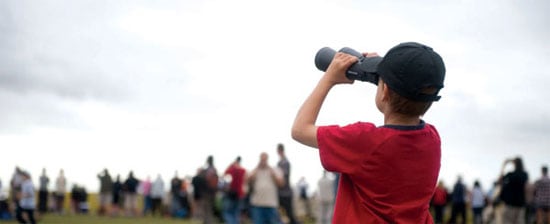
As your child gets older, they will want to use an instrument more like their parents have and there is no reason why they cannot use a standard pair of binoculars.
Indeed in this article: 8x42 or 10x42 Binoculars: Which is Best for Novice / Older Kids, I offer some advice to a reader on just that and it is well worth reading if you are considering buying a standard sized binocular for your child.
In general, I would still advise that you keep the dimensions and weight of the binocular down and that you still maintain a lower magnification as this will make the binocular far easier to use. In this way, I often find that a child will use the instrument a lot more, rather than just becoming frustrated and eventually giving up.
Based on my experience with binoculars and observing my own daughter grow up, at this age range, children often want something more "serious" that does not look like a toy, or a binocular "like dad has got"!
So as a parent you still know that the chances are they will not treat your own more expensive pair of binoculars very well and thus trusting them with them unsupervised may not always be a wise decision. Therefor, I would still recommend that you get a less expensive pair... just incase!
Also, at this age, a child still needs a binocular that is small enough to easily fit into their hands, lightweight and easy to use.
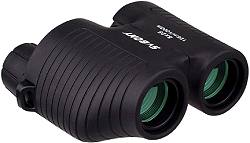 I get a lot of requests to test and review very low cost binoculars from obscure brands from China, indeed it is far more than I could possibly get through and as I generally advise staying clear of most of them.
I get a lot of requests to test and review very low cost binoculars from obscure brands from China, indeed it is far more than I could possibly get through and as I generally advise staying clear of most of them.
However, with offices in Hong Kong as well as manufacturing facilities in central China, Svbony is one of the more popular and well known brands from this region and so when they contacted me, I thought rather than dismissing them outright, I would accept their offer to test their instruments.
Whilst not designed specifically for Children, I chose the Svbony SV10 8x25 binoculars specifically with this purpose in mind and after testing, using as well as giving them to my daughter to try, I am glad that I did, because for kids of around the ages of 7 to 10 years old, I think they make a good option and here is why:
Design & Compact Shape, Ideal for Small Hands
For an adult, the reverse porro prism shape and the compact dimensions make binoculars like this ideal for travel and will easily fit into a coat pocket, but can be a little awkward to use with large hands.
But for kids, this is ideal as it makes them much easier to hold than a full sized instrument.
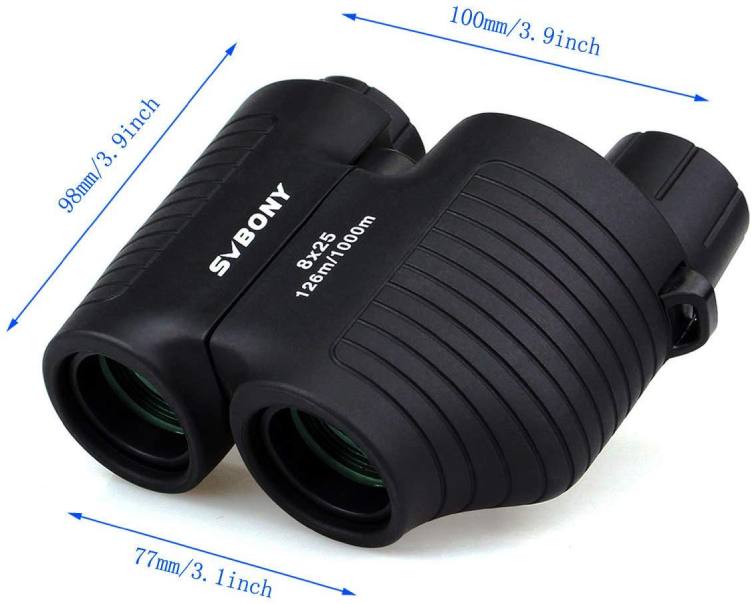
Ideal for Smaller Faces
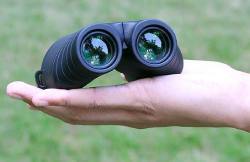 By opening and closing the central hinge, you can adjust the distance between the eyepieces to match the distance between your child's eyes. This IPD (Inter-Pupillary Distance) adjustment range on this instrument goes from a maximum of 7.4cm to a tiny minimum of only 5.6cm and thus will be suitable for children who generally have closer set eyes than adults.
By opening and closing the central hinge, you can adjust the distance between the eyepieces to match the distance between your child's eyes. This IPD (Inter-Pupillary Distance) adjustment range on this instrument goes from a maximum of 7.4cm to a tiny minimum of only 5.6cm and thus will be suitable for children who generally have closer set eyes than adults.
Lightweight
As well as their small dimensions, at only 7.8oz / 221g, the SV10 is also very lightweight, which once again is ideal for children.
Optics & Image Quality
Whilst it is preferable to have features like Fully Multi-Coated Optics and high quality BaK-4 glass prisms, at this price range this is unrealistic to expect. However at this price level, the level of optics is not bad and the resultant image is also far better than what I would have expected to find an instrument at this price to deliver.
Even with very high quality optics and coatings, compact binoculars like these are never going to produce images as bright as large 8x42mm binoculars for example, but for an 8x25mm compact, the image brightness is once again not at all bad and certainly perfectly adequate for most children to use and enjoy.
Wide View
Whilst I would probably have preferred a slightly lower 7x magnification which would help make it easier to keep the image steady and widen the view, measuring 378ft wide at 1,000 yards (126m @ 1000m), the field of view on the Svbony SV10 is more than acceptable, which as we have spoken about above makes it far easier for your child to locate the object that they want to view.
Fixed Focus
Another feature that I really like for children is that these binoculars have a fixed focus optical system. You can learn more about this in my guide to focus free binoculars, but it basically means that they have a really long depth of view and thus don't require any focus adjustments. Indeed they don't have a focus adjustment wheel.
The down side to this is that the minimum close focus is fairly long and thus these are not ideal for viewing things like butterflies from very close range, which if that is an interest of your child is well worth keeping in mind.
But the major advantage is that no focus adjustments are necessary which makes them much easier and less complicated for a child to use. On top of this because there are fewer moving parts, there is less chance of breakage.
Ideal for
Backyard & general birding & wildlife observation. Camping, hiking, holidays (including safaris), outdoor sporting events. Note: Not suitable for very close range uses.
On top of all this, these Svbony SV10 binoculars are very inexpensive: At the time of writing, I found them listed on Amazon for $19.99 / £15.99:
Below are my top recommended choices for older children. As you will see, they are a little more expensive than those for young kids, but as you will also see, the overall level of these instruments is much higher and is in my opinion are well worth the investment for an older child who has a genuine interest in birding, wildlife, the outdoors or indeed for watching sporting events:
 I have owned a pair of Pentax Papilio binoculars for many, many years and to this day, they remain one of my all time favorites and during that time my daughter has also used them many times as she has grown up and so whilst I would say they are perfectly fine for even younger kids than 10 years old, they price, whilst sill not expensive may be a little too high when you are not sure if they will continue to use them. So it is for this reason I am only recommending them for older kids.
I have owned a pair of Pentax Papilio binoculars for many, many years and to this day, they remain one of my all time favorites and during that time my daughter has also used them many times as she has grown up and so whilst I would say they are perfectly fine for even younger kids than 10 years old, they price, whilst sill not expensive may be a little too high when you are not sure if they will continue to use them. So it is for this reason I am only recommending them for older kids.
Containing just two models, the Pentax Papillio series binos have either a 6.5x or 8.5x magnification. Both models are reverse porro prism compacts and use the same body and 21mm objective lenses. As I have mentioned many times in this article, a lower power is very important for kids and so whilst the 8.5x version would be ok, the 6.5x Papilio is ideal.
The unique selling point of the Papillio and indeed where their name comes from (Papillio is french for Butterfly) is their incredibly close minimum focusing distance of only 50cm (1.6ft), making them perfect for observing anything from very close range, including butterflies, dragonflies and flowers, which for kids (and adults!) is excellent.
However, do keep in mind that they can also be used just as effectively as a standard binocular to focus on distant objects, which when combined with their wide field of view, small body and many other features makes them an excellent choice for kids and indeed adults as a binocular for backyard birding, hiking, wildlife observation, camping, watching both outdoor and indoor sporting events, concerts and many other uses. For more: Pentax Papilio II 8.5x21 Binoculars Review.
Price to Performance Ratio
The 8.5x21 Pentax Papilio II Binoculars currently retail for around $130 / £120 putting them just on the edge of what I class as a low-cost ($50 – $130) instrument here on BBR, yet the level of optics and features far exceeds what I would expect at this level and instead they match that of most mid-level binoculars, which is impressive.
I have known about these Opticron binoculars for years and from their main features and specifications alone I have always recommended them as being an ideal choice as the first more serious binocular for an older child.
Now that I have had the chance to fully test and review them, both by myself and with my daughter on a recent kayaking trip, I can honestly say that of all the binoculars on this page these are the ones that I personally would get as the more serious option and is THE pair that I would most comfortably rec come nd to anyone looking for a bino for their kids.
Indeed whilst it is perfect for them, the Opticron Savanna WP 6x30 binocular is far, far more than just a kids binocular and is actually now one of my personal favorite instruments. The wide field of view, ample exit pupil and moderate magnification make it such an easy instrument to use and is ideal for many uses including backyard birding, general birdwatching and wildlife observation (especially at mid to close range) and a whole host of other uses.
For more, be sure to check out my full review.
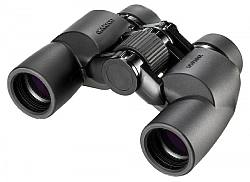 Low 6x Magnification
Low 6x MagnificationSure at approx $130 / £100 these are far from being the cheapest option on this page, but at the same time I do feel that they offer an excellent price to performance ratio. So yes as a throw away instrument for younger kids, this would probably be too much, but if your child is interested in a hobby that requires binoculars, then you can be sure that these will last and they could even continue to use them right up to adulthood and beyond.. or you could of course also borrow them back every now and then too!
 A short while back, I was looking to get myself an inexpensive pair of binoculars to take on a hiking trip and I ended up purchasing the 10x26 Vortex Vanquish, which after testing and then using on my vacation, I was very happy with and now rate as one of the best low cost hiking binoculars currently on the market.
A short while back, I was looking to get myself an inexpensive pair of binoculars to take on a hiking trip and I ended up purchasing the 10x26 Vortex Vanquish, which after testing and then using on my vacation, I was very happy with and now rate as one of the best low cost hiking binoculars currently on the market.
As a compact, low cost binocular (under $100 / £100) for an adult, these 10x26 versions are great, but for an older child, I would say that the slightly lower powered 8x26 version would be more ideal and make the perfect choice as their first serious pair of binoculars.
Compact Design
The reverse porro prism shape, combined with the small 26mm lenses makes for a very easy to use and comfortable to hold instrument for those with smaller hands.
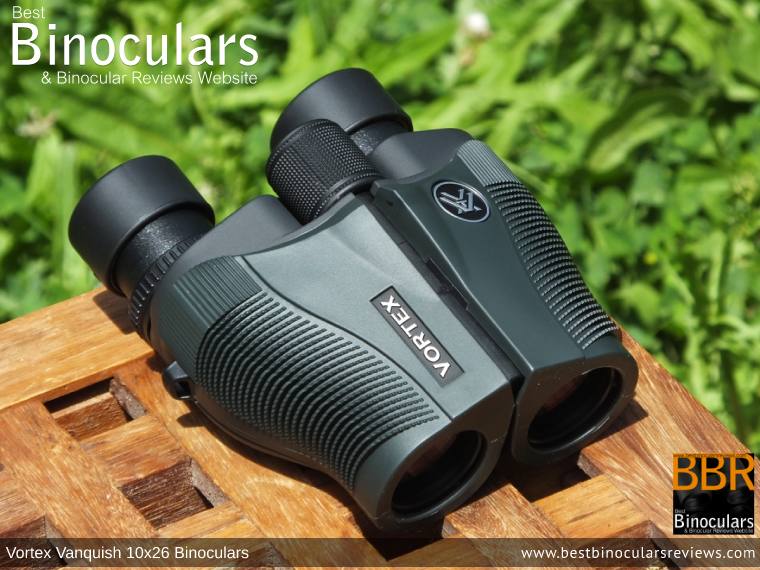
Ideal for Smaller Faces
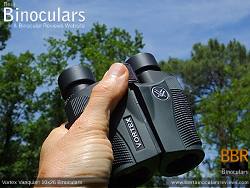 The central hinge on my pair opens and closes easily and smoothly with just enough resistance to ensure they remain at your desired setting.
The central hinge on my pair opens and closes easily and smoothly with just enough resistance to ensure they remain at your desired setting.
Speaking of which, you can adjust it so that they eyecups go from a minimum of 5.7cm apart up to 7.1mm. This IPD (Inter-Pupillary Distance) range is about what I expect for this type of instrument (reverse porro prism compact) and thus should accommodate most users, especially those with closer set eyes like children.
Lightweight
At 12.7ozs / 360g these are not the most lightweight compact binoculars on the market, but they are still what I would consider to be low weight and are far lighter than your average full-sized 42mm and mid-sized 32mm instruments and thus for an older child will be perfectly fine.
Optics & Image Quality
Here it is most important to note that these Vortex Vanquish binoculars are Fully Multi-Coated and I do believe they use the higher quality BaK-4 glass in their prisms, which at this price range is good and certainly not always the case.
When using and testing the 10x26 version, I was very impressed by the image brightness and overall quality of the image produced by the Vanquish and by opting for the lower powered 8x version, the larger exit pupil they produce means that this is only going to get better.
Wide View
As well as making the image easier to keep steady and producing a larger exit pupil, another reason why I recommend the 8x version of the Vanquish for kids is because you get a wider field of view, which as I have already covered above, makes it far easier for your child to locate the object that they want to observe in the view.
Ideal for
Backyard & general birding & wildlife observation. Camping, hiking, holidays (including safaris), outdoor sporting events.
Whilst nowhere a cheap as the binoculars above that I recommend for very young kids, at around $90 / £90, I do eel that these offer excellent value for money and are an ideal first serious level instrument for an older child:
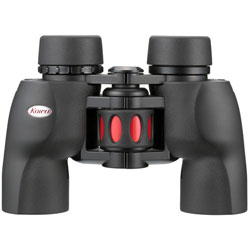 These Kowa's are excellent low cost binoculars designed for children, but in my opinion are also great for adults as well!
These Kowa's are excellent low cost binoculars designed for children, but in my opinion are also great for adults as well!
When I tested and reviewed the bigger brother, the Kowa YF 8x30 binoculars some years back, I was super impressed. In fact they won my award as the best low cost binocular for that year.
Designed for Smaller Hands & Faces
The great news is not only does the 6x30 version costs even less, but it is more lightweight (16.5ozs / 470g) and still has all the same optical features and components:
The mid-size, traditional porro prism shapes makes for a very comfortable end ergonomic shape to hold onto, especially for those with smaller hands. They also have a very large and easy to use focus wheel.
Unlike the others on this page, these are also fully sealed and thus waterproof as well as fogproof as the interior has been filled nitrogen gas.
This more traditional shape also means that the eye-pieces are closer together than the objective lenses, which is ideal for younger ones or anyone who has more close set eyes.
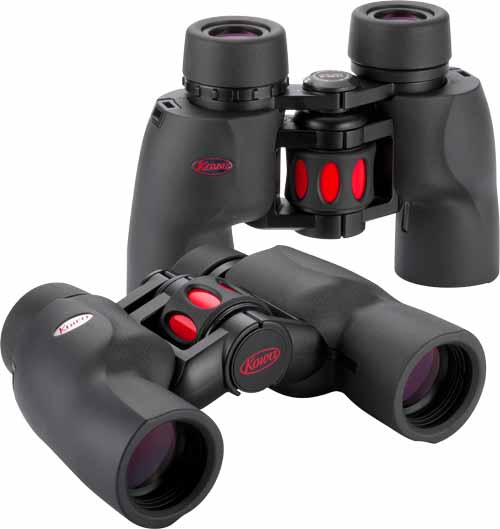
Low 6x Magnification & Very Wide View
As we have already discussed the low 6x power makes it much easier for more unsteady hands to keep the image still, but this also means that you get a much wider view, which in turn makes it far easier for anyone, but especially a child to lock onto whatever they want to view through the instrument.
All these features above are great, but where the Kowa 6x30 beats just about any other kids binocular is in the quality of their optics. Here you are getting exactly the same optical system as the adults version which includes:
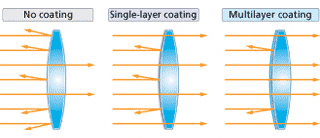 Fully Multi-Coated Optics
Fully Multi-Coated Optics
All the others on this page either don't mention the coatings (which means they are nothing special and probably single or none at all) or at best they only have multi-coated (so not all lenses are coated). Being Fully Multi-Coated plays a very important role in ensuring that a bright, high quality image is produced and the difference is clearly visible when you compare them.
External Protective Lens Coatings
Kowa have also added a material to the outer lens surfaces that protects them from dirt and dust and also makes it easier to remove the inevitable fingerprints form the glass. This is important because the easier it is to clean a lens, the far less chance you have of damaging them when doing so. Note coatings like these are only commonly found on mid to high end optics, so to see them here is impressive and a sure sign that Kowa have paid particular attention to designing a very child friendly instrument.
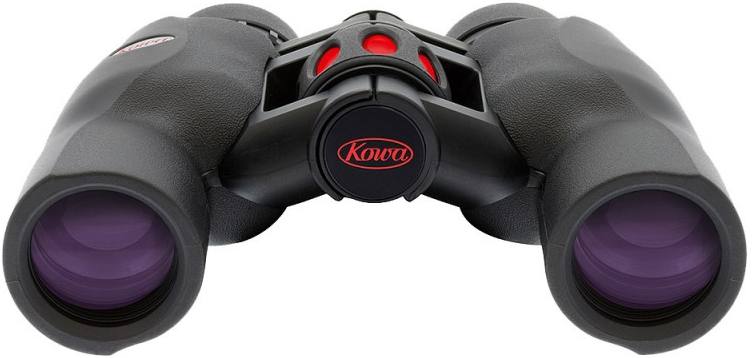
BaK-4 Porro Prisms
Unlike most other child binos, these have porro and not roof prisms. The advantage here is this design of prism does not require expensive mirror coatings or phase correction coatings to achieve the same optical performance level.
As all the roof prism ones below are very inexpensive, you can be sure that none of them use these coatings and so will never achieve the same optical performance as this or any other porro prism instrument.
On top of this the prism on this Kowa is make from high quality BaK-4 glass, which is superior than the BK-7 glass used by almost any other in this category.
Ideal for
Backyard & general birding & wildlife observation. Camping, hiking, holidays (including safaris), outdoor sporting events.
At around $85 / £80, sure they do cost more than the much cheaper, more plastic binoculars below. But in my opinion, for older kids and as long as they can look after them, then the quality of the optics and the resultant much higher quality view you get through these will enhance their enjoyment and make for a much better experience and hopefully a hobby that they can get into for life.
So if you can afford it and you want a "real" quality binocular for your child that is truly as good as an adult version, then these are the way to go:
The binoculars below are my top recommendations for older children, teenagers and even adults with smaller hands and faces. Here I think the same principals that we have already discussed remain valid, but instead of opting for a "kids" specific device we can look for the ideal standard bino:
Once again, these 6x30 Opticron binoculars are perfect for this age range and I cant highly rec come nd them enough. As I have already written about them (see my top choice for 10+ years above), I won't repeat myself, rather take some time to read the full review for more details.
 Low 6x Magnification
Low 6x Magnification Levenhuk Rainbow Binoculars
Levenhuk Rainbow BinocularsThe Rainbow series consists of seven very colorful, low cost compact binoculars that whilst not specifically designed for kids, are perfect for them and make what I believe an ideal introduction into the world of optics. Indeed as you can see from the photo below, my 5 year old daughter has and uses a pair.
Optical features include the use of BaK-4 Roof Prisms and Multi-Coated Optics.
The chassis are completely sealed and filled with nitrogen gas making them water and fog proof. They also feature twist-up eyecups, something that is fairly rare at this price level on a compact.
However the biggest highlight for me is their double hinge design, which allows them to be folded up into a tiny package when not in use - these are true pocket binoculars and once again makes a big difference for those with small hands and pockets.
Available Models:
There are currently 7 models within the Rainbow series, all of which are identical apart from the colors. Colors available are White Snow, Red Berry, Orange, Lime, Lemon, Blue Wave and Amethyst.
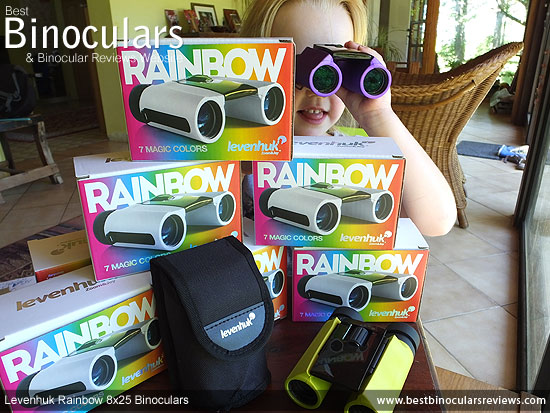
![]() Prices & Where to Buy
Prices & Where to Buy
These cheap compact binoculars retail for about $60 in the US and £55 in the UK:
Below are some more examples of standard binoculars that I believe are most suitable for older children that I have fully reviewed:
They are either all lightweight, reasonably compact, have a magnification of 8x or less and are fairly inexpensive and where known I have limited their minimum IPD (Interpupillary Distance) to being 5.2cm or less and so should be able to adjust to fit their smaller faces:
|
A compact binocular that the Transformers would be proud of! The Pentax VD 4x20 can be split in half and thus converted into two 4x monoculars, which in turn can be placed end-on-end, transforming it once again into a mini-sized, but powerful 16x Spotting Scope! Price: (3/6) Mid Priced Binoculars | |||||||||||||||
|
|
Comfortable, easy to carry about and with a bright, good quality image, I love using these Opticron Savanna WP 6x30 binoculars, which I think this will also be the case for many people looking for an inexpensive, easy to use binocular as I feel they offer a good compromise between size, weight and image quality, and brightness. Highlights include an excellent price to performance ratio, a wide field of view, steady 6x magnified image and a huge amount of eye-relief. Price: (2/6) Low Cost Binoculars | |||||||||||||||
|
|
Bright and colourful, these National Geographic binoculars are made by the German optics company Bresser and are specifically designed for younger children. The lightweight and very compact body is perfect for small hands and faces and the low 6x magnification ensures a wide field of view and an image that kids with shaky hands can keep still to ensure a good view... Price: (1/6) Cheap Binoculars | |||||||||||||||
|
|
With an extremely wide field of view and low power, these small, easy to carry Vixen binoculars offer a unique view of the stars and complete constellations. This along with their exceptional low light capability also make them and excellent choice as a high quality pair of opera or theatre glasses and a host of other uses. Price: (3/6) Mid Priced Binoculars | |||||||||||||||
|
|
Originally designed for the theater, the high quality Japanese made Kabuki Glasses are also ideal for many other hands free uses like the opera, ballet, concerts and both outdoor and indoor sporting events.
Price: (3/6) Mid Priced Binoculars |
 More Information & Related Content
More Information & Related Content